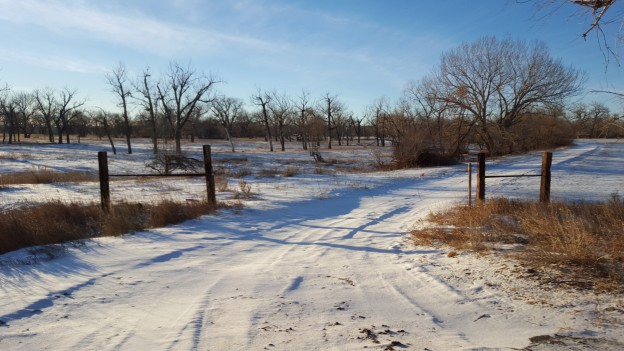My brother bought a black suit when he married at 45, remarking, “I’m going to be attending a lot of funerals,” a reasonable proposition at my age. We lost several people close to us last year, prompting me to reflect on my own mortality: how would I like to be remembered; what music I’d like at my memorial; whether to leave an estate or spend it all before I go.
I remember wakes more than funerals. It’s not the line of people waiting to comfort the bereaved and pay their last respects to the dearly departed. Rather, it’s the visual tribute and chronology of a life that leave more of an impression, particularly if one had been acquainted for a relatively short time. We used to assemble photo collages on poster board; now images can be digitally uploaded to a computer and played on a wall-mounted monitor, complete with soundtrack.
It usually starts with the square black and white glossy snapshots from the 1940s or 1950s, shot with a Brownie box camera. We were babies or little kids and death was an abstraction that never crossed our minds. I notice the backgrounds more often than the subject, recalling my own childhood. Living rooms with obnoxious floral wallpaper that was once trendy. The sturdy couch, armchair and ottoman, covered in a short-napped, rust-colored upholstery that felt like a fresh buzz-cut when you ran your hand over it. Sometimes there was a heavy mantle clock which required winding with a key. It was made with wood and the chime was real, not electronic.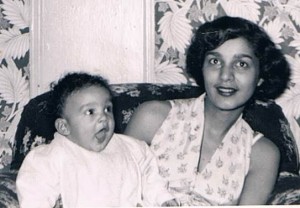
Kitchens had refrigerators with rounded corners and latches, white gas stoves with pilot lights, and gleaming six-inch ceramic tiles (ours were yellow with black trim). Most average folk didn’t have a formal dining room like the Cleavers or Dr. Stone and his wife. More often a chrome and laminate dinette set with vinyl-covered chairs sat in the middle of the kitchen. At least one photo had a kid in a high chair, or, as with my sister, sitting ON the table while pouring out the sugar bowl. 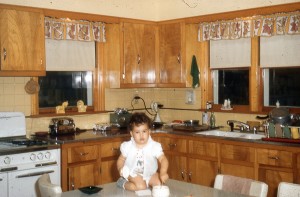 Often a little one sat on the lap of a father or grandfather, dressed in a white T-shirt and dungarees, both of them smiling for the camera. Or the look was more subdued, suggesting Dad wasn’t quite used to having a squirming tax deduction. Grandmothers with short silver hair wore a severe, disapproving look behind those black, butterfly eyeglasses. They always wore dresses; no jeans, slacks or pant suits.
Often a little one sat on the lap of a father or grandfather, dressed in a white T-shirt and dungarees, both of them smiling for the camera. Or the look was more subdued, suggesting Dad wasn’t quite used to having a squirming tax deduction. Grandmothers with short silver hair wore a severe, disapproving look behind those black, butterfly eyeglasses. They always wore dresses; no jeans, slacks or pant suits. 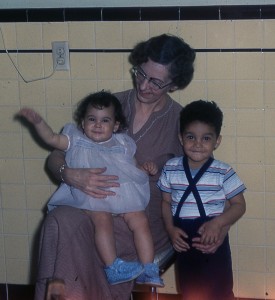
Photographs evolved with the lives they recorded, becoming color prints or Kodachrome slides, which held up much better than the Instamatic pictures from the 1980s that would fade into various shades of red and brown. Siblings sat beaming in front of a real Christmas tree with those big clip-on light strings, surrounded by toys we’ve forgotten ever existed. There were snapshots of First Communion and Confirmation if you were Catholic, or the full-body dunk if you were Baptist. (I’ve never been to a Jewish funeral but I’m sure Bar Mitzvah pictures are prominent.) The years roll on with memories of family vacations; eight grade graduation; the first car if the parents had money or, more likely, a shot of the first driver’s license. High school prom if you were one of the cool kids. High school graduation and impending adulthood. Be careful what you wish for.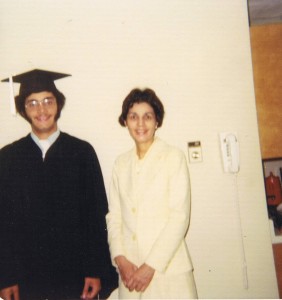
The paths often diverged from here. Some went to college, then got married. A few married right out of high school and went to work. The bride and groom looked so young in those photos. Then they started having their own kids, assuming the mantle of parenthood from those now content to be grandparents. As one photographic cycle continued another one began. Before they knew it, those kids were grown with kids of their own and the roles shifted yet again.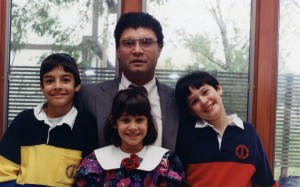 For the most part everyone turned out OK. Occasionally a wayward child turned into a troubled adult despite the best efforts, something no one wants to talk about. Even more tragic was a child lost to illness, accident or war, a premature departure that remains painful and triggers tears.
For the most part everyone turned out OK. Occasionally a wayward child turned into a troubled adult despite the best efforts, something no one wants to talk about. Even more tragic was a child lost to illness, accident or war, a premature departure that remains painful and triggers tears.
Photos became larger and sharper in the twilight years. Digital cameras eliminated the trip to the developer for prints. Smart phones then surpassed digital cameras and entire albums were a finger-swipe away. Many a parent converted a shoe box full of memories to a digital archive; but they would never be anything like the originals.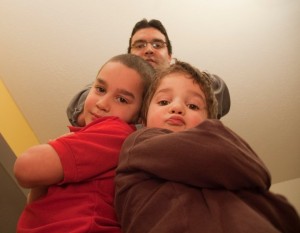
By now our grandparents are long gone. Our parents are leaving us one by one, sometimes later than expected as they live into their eighties and nineties, instead of having the big one in their sixties like they did when we were kids. Ironically that’s where we find ourselves now. We’ve come full circle.
The final episode of the original Twilight Zone was “Passage on the Lady Anne.” A young couple boards an aging cruise ship only to discover the other passengers are all quite elderly and find their presence unsettling. The pair is eventually forced off the ship and into a lifeboat, because this trip is, for them, premature. The others are sailing towards the Final Destination
We’re all booked on the Lady Anne. Sooner or later we’ll find a ticket in our hand, waiting our turn to board.
